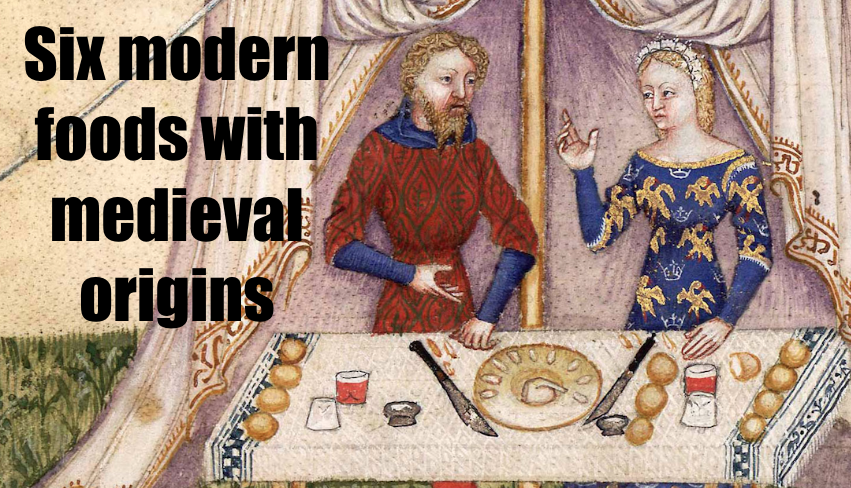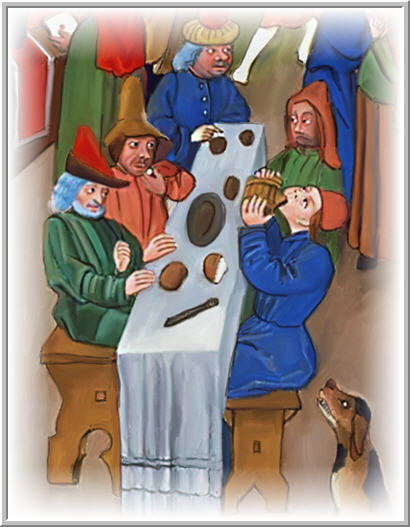

This site may contain copyrighted material the use of which may not be specifically authorized by the copyright owner. The publication of any and all content eg, articles, reports, editorials, commentary, opinions, as well as graphics and or images on this website does not constitute sanction or acquiescence of said content unless specified it is solely for informational purposes. For those who want to understand the History, not just to read it. In great houses the evening selection would be limited accordingly. The Church frowned on late suppers, claiming they made men gluttonous. While the upper class dined in splendor the lower class ate coarse bread, pottage, milk, cheese and unseasoned meat. There were also courses of cream, cheese slices and strawberies or plums stewed in rose-water. Sturgeon could be cooked in parsley and vinegar and seasoned with ginger. There might also be silver crusted pies filled with deer, gosling, chicken and rabbit and flavored with saffron and cloves. The first course of a meal might consist of a stag’s head cooked and replaced in its own skin, still bearing its superb antlers. The centre-piece at one such feast was a silver hollow fortress that formed a cage in which several live birds were shut up, their tufts and feet being gilt. Long peacock feathers and green branches tied with flowers might surround an ornate centre-piece. Huge stepped buffets covered with rich drapes were assembled for use at banquets and feasts. Cucumber, while available, was supposed to be unwholesome owing to the fact that the people of France ate a lot of it and were subject to periodic fevers. Nevertheless there were many vegatables available including onions, parsnips, garlic, watercress, lettuce, cabbage, leeks, carrots, artichokes, beans, peas, lentils and asparagus. They were used almost exclusively by monastic communities under vows of extreme abstinence. Vegetables were not considered by the general populace as able to provide much in the way of nourishment.
#Disgusting medieval foods skin
Owing to their aversion to raw foods, rich nobles lacked vitamin C and fibre which led to bad teeth, skin disease, scurvy and rickets. The wealthy ate little fresh fruit and viewed such unprepared food with suspicion, preserving it in honey and serving it in pies. Strawberries, raspberries and red currants could be found in the woods. Fruits and Vegetables in Medieval Timesįoreign trade brought exports of apricots, plums, peaches, figs, pears and apples. ‘Small beers’ were sweetened quite simply using honey or might be scented with ambergris or raspberries. Another was loaded with spices – allspice, juniper, bread-crumbs, lavender and a number of other additions being thrown in. One strong beer was called godale, from the German meaning ‘good beer’. The people of the middle ages drank ale, beer, mead or cider as well as different types of wine. Venison was reserved for kings and the rich.
:max_bytes(150000):strip_icc()/479511499-56a48f525f9b58b7d0d78b7d.jpg)

Also eaten were peacocks, hedgehogs and squirrels. Game birds such as the heron, crane and crow were considered delicacies. Geese were so highly prized that flocks of them were driven to feed in the fields like a flock of sheep. Unscrupulous butchers would attach the tail of a kid to a lamb in order to deceive the customer into paying a high price for a less expensive meat. Such ulcers were believed to be a sign their flesh would communicate leprosy to those who ate it.

Prior to food preparation the underside of the pig’s tongue was inspected for white ulcers. Pork was the most common meat served at great tables in the form of hams, sausages and black pudding. In this the lower classes had an advantage, their tables being only a few steps from the fire on which the meal was cooked. As the kitchen in manor houses and castles might be situated at some distance from the Great Hall, food was often served cold. Everyone had their own knife and soups were drunk from a cup. The upper classes ate fine white bread, the lower classes coarse rye and barley breads. Nobles and royals ate their food from silverware and golden dishes while the lower classes used wood or horn dishes. What was eaten and how it was served varied considerably depending on social station. The staple diet of medieval man was bread, meat and fish.


 0 kommentar(er)
0 kommentar(er)
